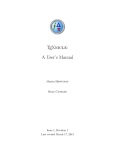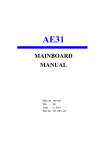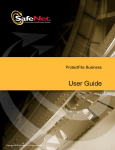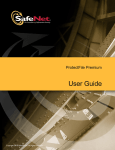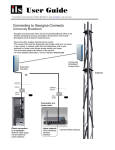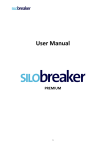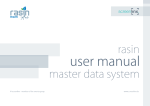Download \Fuji Xerox
Transcript
US 20090193350A1
(19) United States
(12) Patent Application Publication (10) Pub. No.: US 2009/0193350 A1
(43) Pub. Date:
CARTER et al.
(54)
SYSTEM AND METHOD FOR SUPPORTING
(60)
DOCUMENT NAVIGATION ON MOBILE
DEVICES USING SEGMENTATION AND
KEYPHRASE SUMMARIZATION
(75) Inventors:
Provisional application No. 61/024,087, ?led on Jan.
28, 2008.
Publication Classi?cation
(51)
Int. Cl.
G06F 3/048
(52)
U.S. Cl. ...................................................... .. 715/765
Scott CARTER, Los Altos, CA
(US); Francine CHEN, Menlo
Park, CA (US); Patrick CHIU,
Menlo Park, CA (US)
Jul. 30, 2009
(57)
(2006.01)
ABSTRACT
Correspondence Address:
Described is system that characterizes segments of document
SUGHRUE MION, PLLC
2100 PENNSYLVANIA AVENUE, N.W., SUITE
With one or more keyphrases and then uses keyphrases to help
800
WASHINGTON, DC 20037 (US)
(73) Assignee:
FUJI XEROX CO., LTD., Tokyo
(JP)
(21) Appl. No.:
12/268,343
(22) Filed:
Nov. 10, 2008
Related US. Application Data
(63) Continuation-in-part of application No. 12/242,757,
?led on Sep. 30, 2008.
users ?nd interesting parts of document. Keyphrases are dis
played With information about the location of the phrase in the
document and are used as pointers to quickly move to from
overvieW to section of potential interest. In another imple
mentation, When there are many documents in a collection,
inventive multi-document vieW can be used to reduce number
of documents presented, helping user to more e?iciently ?nd
documents of interest. In this vieW, a user (possibly repeat
edly) ?lters documents displayed based on metadata values.
In one implementation, icons corresponding to documents
are displayed on a display device together With metadata
corresponding to the documents. When the value of the meta
data is selected by the user, display state of the icons corre
sponding to document is varied based on selected value of
metadata.
I all
‘g’ CI
260
/‘
./
/f
.Jf/
/‘
20*:
\Fuji Xerox
Toyota Motor
,. Global Project
232”
cusiomersarvice
EEK
fumes...
I’X/
Patent Application Publication
101
Y-lll
|:li su
Jul. 30, 2009 Sheet 1 0f 8
102 105
US 2009/0193350 A1
104
// // {is Y-lll
‘if ’lorém
Ui su
l’ ] lorbm
E
4
4
103
Figure 1
Patent Application Publication
i
I
x
/f
263 \
i:
__
3‘
W ----m
\x\
US 2009/0193350 A1
ix
.
t
~
/
x’
Jul. 30, 2009 Sheet 2 0f 8
238
W
x”
z’
f/
J/
-—
\\
»------
f’
fr
1
f
1
l
x’
W
261
\Fuji Xemx
Tnyuta Mater
?lebal Project
292 ~-*’
swimmer-service
Exit
full screen
Figure 2
Patent Application Publication
Jul. 30, 2009 Sheet 3 0f 8
US 2009/0193350 A1
Y all
Frontline Reports
My‘! Fug‘i Xerox ----
2 Toyota- Motor 1
3 Global Pmject
4 custnmer sewice
382
5 service manual
6 Fuji Xerox
Exit
Figure 3
-
/
Patent Application Publication
Jul. 30, 2009 Sheet 4 0f 8
US 2009/0193350 A1
400
495
I
,4
$.11]
Toyuta M01101’
Global Pmiect
Fuii XBFQX
cuswmer service
T?y?’ia MW)!’
/
service manual
Eiobal Prqject
/
cusfamer sgwica
/
Exit
full screen f’Exit
1’
"
4192
Figure 4
I
\\\
/l
40a
401
Patent Application Publication
Jul. 30, 2009 Sheet 5 0f 8
US 2009/0193350 A1
501
500
// / /
\
/
////
/
Lorem
503
E2 lpsum dolor
3
2
Sit amet
Consectetuer
Figure 5
502
Patent Application Publication
Lu]
Jul. 30, 2009 Sheet 6 0f 8
US 2009/0193350 A1
‘4*
U
B
Keyphrases
Keyphrases
CD
.
'1 Collaboration
Collaboration
602
Search
Search (+)
|:' [I ‘:l El Display
III
‘I
Display
Of?ce
Office
Video
Video ( - )
603
El
El
601
Exit
Exit
Figure 6B
Flgure 6A
Lul
E‘
‘*3
~111
Keyphrases
Authors
Collaboration
Remix moms: Rede?ning the ..
g.golovchinsk
y
Search
604
j.adcock(+)
Display
j. pickens
El
Reading
IIIin
Offlce(+)
p.chiu
Video
s.carter
UbiMEEl':De
III
Virtual Physics Circus
Exit
Figure 6C
Exit
Figure GB
605
Patent Application Publication
Jul. 30, 2009 Sheet 7 0f 8
own
a:
tn
&
.1
652A5
no»
//
ooh
US 2009/0193350 A1
%
0:
Patent Application Publication
Y-lll
Jul. 30, 2009 Sheet 8 0f 8
{is
800
|:li sum L1] 3 lorem
|_|
_|
US 2009/0193350 A1
801
/
804
Z
Unit
El
'3 |_
U
_|
LE
1
(W
Processing Unit
D
sit aget
L B
Display
[I
Controller
Exit
Figure 8
Jul. 30, 2009
US 2009/0193350 A1
SYSTEM AND METHOD FOR SUPPORTING
DOCUMENT NAVIGATION ON MOBILE
DEVICES USING SEGMENTATION AND
KEYPHRASE SUMMARIZATION
also includes audio cues that include keyphrases for the docu
ment text as Well as ?gure captions. HoWever, this approach
does not augment manual interaction, and relies on audio,
Which at times may be unavailable or inappropriate.
CROSS-REFERENCE TO RELATED
APPLICATION
IEEE Spectrum. February 2007, an iLiad document reader
[0008] In M. Hood, E-NeWspapers: Digital Deliverance?
[0001] This regular US. patent application is based on and
claims the bene?t of priority under 35 U.S.C. 119 from pro
visional US. patent application No. 61/024,087, ?led on J an.
28, 2008, the entire disclosure of Which is incorporated by
reference herein.
[0002]
This application also claims the bene?t of priority of
and is a continuation-in-part of US. application Ser. No.
12/242,757, by common inventor Scott Carter, Francine Chen
and Patrick Chiu, ?led Sep. 30, 2008, and entitled “SYSTEM
AND METHOD FOR SUPPORTING DOCUMENT NAVI
GATION ON MOBILE DEVICES USING SEGMENTA
TION AND KEYPHRASE SUMMARIZATION,” Which, in
turn, claims the bene?t of priority under 35 U.S.C. 119 from
provisional US. patent application No. 61/024,087, ?led on
Jan. 28, 2008. Application Ser. No. 12/242,757 is fully incor
porated herein by reference for all purposes.
FIELD OF THE INVENTION
[0003]
This invention generally relates to presenting infor
operates to overlay the title and ?rst sentence of neWs articles
on top of the full document.
[0009]
Hearst’s TileBars, described in TileBars:V1sualiZa
tion of Term Distribution Information in Full Text Informa
tion Access, Pages: 59-66, ACM CHI ’95 (1995), include
roWs of tiles corresponds to the results of query term sets,
Where each tile represents a text segment, and the length of a
roW represents the length of the document. The term fre
quency is indicated by the gray level of the tile, and the term
distribution by these tiles as they appear in the overall graphic
representation.
[0010] Rattenbury and Canny’s CAAD system, described
in CAAD: An Automatic Task Support System. Pages: 687
696. ACM CHI ’07 (2007), represents collections of docu
ments in a pannable, Zoomable interface. HoWever, this sys
tem clusters ?les related to a common activity rather than
keyphrases, and the display is not designed for a mobile
interface. Additionally, Leuski’s Lighthouse, described in
Lighthouse: shoWing the Way to relevant information, Pages:
125-130. IEEE InfoVis ’00 (2000), is a search engine that
presents returned documents With both a ?at list and a cluster
mation on information displays and more speci?cally to using
displays of small siZe to render documents in the form con
venient for vieWing by a user.
of spheres positioned according to the similarity of their
corresponding documents.
[0011] Despite the foregoing advances, the conventional
BACKGROUND OF THE INVENTION
e?icient use of displays of small siZe to render documents in
the form convenient for vieWing by a user.
industry approaches are de?cient in their ability to facilitate
[0004]
The siZe limitations of ultra-portable hand-held
devices, such as cell phones or PDAs limit the siZe of the
screen area available for vieWing information. This makes it
hard for users to read textual information using such a device.
[0012]
Various solutions to this problem are being developed in the
and systems that substantially obviate one or more of the
industry.
above and other problems associated With conventional tech
niques for displaying of documents on small information
[0005]
There are many methods that have been proposed
for vieWing documents and Web pages on small screens. For
example, Woodruffet al ., Using thumbnails to search the Web
Pages, 198-205, ACM CHI ’01, augment Web search by auto
matically increasing the font siZe of search terms on returned
documents. While the authors did not design their system for
SUMMARY OF THE INVENTION
The inventive methodology is directed to methods
displays.
[0013] Various embodiments of the inventive concept
include devices, methods and computer readable mediums
containing computer code for identifying multiple segments
use on mobile devices, it could be implemented on mobile
of a document, determining at least one keyphrase and asso
ciating the determined at least one keyphrase With each iden
phone Web broWsers. HoWever, the described approach does
ti?ed segment, displaying the determined least one key
not use text summaries of segmented regions; only increases
font siZe in situ rather than offering multiple different visu
aliZations and interactors and also does not provide mecha
nisms for visualiZing keyphrases across a non-Web document.
phrase, and upon a user’s selection of the least one keyphrase,
enabling the user to vieW the corresponding segment of the
document.
[0006] Berkner et al., Image and Display Dependent
Thumbnails, Pages: 53-65, SPIE ’04, create a condensed
vieW of a document page, or a SmartNail, by generating a
[0014] Various embodiments of the inventive concept also
include a device With a display unit, a sensing unit, Which is
con?gured to sense input, a processing unit, Which is operable
to process the input, to identify multiple segments of a docu
layout With minimal White space that is composed of selected
ment; and to forWard instructions to a display controller to
text in a readable siZe and selected images. In the created
highlight, Zoom, or navigate through the identi?ed document
segments; and the display controller operable to process the
condensed vieW, the original document layout is usually
changed. The goal of this study is to create a readable thumb
nail for smaller displays such as PDAs. HoWever, in the
described system, there is no indexing betWeen different sec
tions and the original text.
[0007] The system described in Erol et al., Multimedia
Thumbnails for Documents, Pages 231-240, ACM Multime
dia ’06, automatically creates an animation that pans to
important segments on a Web page. The described approach
forWarded instructions and to generate a resulting visual rep
resentation for display on the display unit. The processing
unit is further con?gured to determine at least one keyphrase
and associate the determined at least one keyphrase With each
identi?ed segment.
[0015] Various embodiments of the inventive concept also
include devices, methods and computer readable mediums
for displaying documents as visual representations and
Jul. 30, 2009
US 2009/0193350 A1
grouping the documents based on the occurrences of key
functional elements are designated With like numerals. The
phrases; Wherein the siZe of each visual representation
aforementioned accompanying draWings shoW by Way of
illustration, and not by Way of limitation, speci?c embodi
depends on a function of the number of occurrences of all
keyphrases in the corresponding document, highlighting all
of the visual representations With at least one occurrence of a
selected keyphrase; and highlighting only visual representa
tions With at least one occurrence of each selected keyphrase
When multiple keyphrases are selected.
[0016] Various embodiments of the inventive concept
include methods, computer programming products and sys
tems for preparing multiple documents; determining at least
one value of at least one type of metadata corresponding to
each of the multiple documents and associating the at least
one value of the metadata With the corresponding document;
displaying multiple icons corresponding to the multiple docu
ments in 2 or 3 dimensions in a ?rst display region and at the
least one value of the metadata at a second display region; and
selecting the at least one value of the metadata for varying the
ments and implementations consistent With principles of the
present invention. These implementations are described in
suf?cient detail to enable those skilled in the art to practice the
invention and it is to be understood that other implementa
tions may be utiliZed and that structural changes and/ or sub
stitutions of various elements may be made Without departing
from the scope and spirit of present invention. The folloWing
detailed description is, therefore, not to be construed in a
limited sense. Additionally, the various embodiments of the
invention as described may be implemented in the form of a
softWare running on a general purpose computer, in the form
of a specialiZed hardWare, or combination of softWare and
hardWare.
[0029] VieWing and identifying interesting sections of
documents on a small screen, such as on a cell phone or PDA,
display states of the multiple icons in the ?rst display region
is dif?cult. An embodiment of the invention provides a
based on the selected at least one value of the metadata.
method that uses keyphrases for easily moving to interesting
[0017] Additional aspects related to the invention Will be
set forth in part in the description Which folloWs, and in part
Will be obvious from the description, or may be learned by
practice of the invention. Aspects of the invention may be
sections of the document While at the same time helping users
to be aWare of document context as they read portions of the
document.
realiZed and attained by means of the elements and combina
Technical Details
tions of various elements and aspects particularly pointed out
in the folloWing detailed description and the appended
claims.
[0018] It is to be understood that both the foregoing and the
[0030] To process a document and create a visualiZation,
sections, or segments, of text are ?rst identi?ed. In our imple
folloWing descriptions are exemplary and explanatory only
mentation, these sections generally correspond to paragraphs
or ?gure captions. The sections could alternatively be speci
and are not intended to limit the claimed invention or appli
cation thereof in any manner Whatsoever.
?ed to be coarser, such as text under a sub-heading. Next, one
or more keyphrases are associated With each text section. The
BRIEF DESCRIPTION OF THE DRAWINGS
keyphrases and identi?ed sections are then used by the inter
face for visualiZing and interacting With the document.
[0019]
The accompanying draWings, Which are incorpo
rated in and constitute a part of this speci?cation exemplify
the embodiments of the present invention and, together With
the description, serve to explain and illustrate principles of
Text Section Identi?cation
[0031]
The input document may be a set of imaged pages,
such as from a scanned paper document, or an electronic
the inventive technique. Speci?cally:
document. If the input document is imaged pages, layout
[0020] FIG. 1 illustrates a multi-document vieW in accor
dance With an embodiment of the inventive concept.
phrase selection list in accordance With an embodiment of the
analysis and OCR is ?rst performed on the document. This
may be done by separate components or by a more sophisti
cated OCR system, such as that marketed by Nuance (http://
WWW.nuance.com) or ABBYY (http://WWW.abbyy.com),
inventive concept.
Which Will convert a scanned document into a PDF document.
[0021]
FIG. 2 illustrates document overvieW With key
[0022] FIG. 3 illustrates page overvieW in accordance With
an embodiment of the inventive concept.
[0023]
FIG. 4 illustrates re?oW (left) and Zoomed (right)
vieWs in accordance With an embodiment of the inventive
concept.
[0024]
FIG. 5 illustrates alternative keyphrase selection list
[0032]
Working With electronic documents With some
markup, such as some PDF documents, the sections of text
can be identi?ed either directly from the tags, or if the tags do
not contain section information, then sections can be identi
?ed using heuristics based on line spacing, font height, and
indentation. For example, regions of text With the same line
spacing and font height are considered to be in the same
in accordance With an embodiment of the inventive concept.
[0025] FIG. 6A-6D illustrate another example of a multi
document vieW in accordance With an embodiment of the
current line is the beginning of a neW section. A larger spacing
inventive concept.
betWeen a pair of lines also indicates the start of a neW section.
[0026]
section unless the left edge is indented, indicating that the
FIG. 7 illustrates an exemplary embodiment of a
computer platform upon Which the inventive system may be
implemented.
[0027] FIG. 8 illustrates an example functional diagram of
hoW the present invention relates to the computer platform.
DETAILED DESCRIPTION
[0028] In the folloWing detailed description, reference Will
be made to the accompanying draWings, in Which identical
Keyphrase Discovery
[0033]
There are a number of Ways to identify keyphrases,
and any can be used (Turney, 1997). A straight-forward
method is by tagging the par‘t-of-speech (POS) of the text and
then identifying POS tag sequences that correspond to a noun
phrase (Turney, 1997). Another method is to identify
sequences of Words betWeen “stop Words”, or non-content
Words (Chen, 1995).
Jul. 30, 2009
US 2009/0193350 A1
[0034] When a document has multiple sections and key
phrases are selected to be representative of each section, there
keyphrases With a speci?ed maximum number of terms per
keyphrase and a ranking of keyphrases can be used.
are methods that take into account previous key Words or
keyphrases that have already been identi?ed in the text, and to
Interfaces
give greater Weight to terms that have not been selected as a
[0047] The system supports multiple different visualiZa
tions and interaction techniques.
keyphrase. Carbonell and Goldstein (1998) proposed the use
of Maximal Marginal Relevance to rank documents using a
Weighted combination of the similarity of a document to a
query and the similarity of a document to previously selected
documents. Brants et al. (2004) propose the selection of key
Words and keyphrases for interactive topic-based summari
Zation using a statistical measure of segment characteriZation
and differentiation, such as pointWise Mutual lnforrnation.
[0035] An embodiment of the inventive method for identi
fying keyphrases identi?es sequences of Words betWeen stop
Words as candidate keyphrases. For each section of text, the
candidate’s keyphrases are scored and the best N keyphrases
selected, Where N is pre-speci?ed and may be dependent on
the amount of screen space available in the application.
[0036] To select the best keyphrases, We use a Weighted
combination of features, similar in spirit to a maximum
entropy model. Keyphrases are found for each section, taking
into account the keyphrases selected for other sections. The
selection could be optimiZed over all combinations, but for
simplicity, We order the text sections and then select key
[0048] FIG. 1 illustrates a multi-document vieW in accor
dance With an embodiment of the inventive concept. On the
collection overvieW screen 100, keyWords that best describe
the set of documents in the collection are distributed about the
interface 101. Each document is represented by a square 102.
Square location is determined by the number of occurrences
of the displayed keyWords in the corresponding document.
For example, the document represented by a square 105 in
FIG. 1 is located slightly closer to ‘ipsum’ than ‘lorem’, and
not near ‘dolor’ or ‘sit amet’. This indicates that the term
‘ipsum’ occurs more times than ‘lorem’ in the document, and
that the terms ‘dolor’ and ‘sit amet’ do not occur in the
document. Square siZe is determined using the sum of the
occurrences of all keyphrases currently in vieW in the corre
sponding document (thus, a small square may represent a
large document that is not Well represented by the keyphrases
currently in vieW). Selecting a keyphrase highlights all of the
squares of documents With at least one occurrence of that
keyphrase 103 (in this case, “ipsum”). When multiple key
phrases for each text section, one section at a timer. The
features are text based and include:
phrases are selected, only the squares of documents With at
[0037]
104 (in this case, “ipsum” and “lorem”). This approach could
be scaled to larger sets of displayed keyphrases using combi
1 . tfsecz number of times a term occurs in the current
section
[0038] 2. tfdocz number of times a term occurs in the docu
ment
[0039]
least one occurrence of each selected keyWord are highlighted
nations of pan-and-Zoom interaction techniques and 3D visu
aliZations.
3. dfEng: number of documents in Which a term
occurs at least once in an English corpus. We used a list from
[0049] FIG. 2 illustrates document overvieW With key
phrase selection list. On the document overvieW screen 200,
the Berkeley and Stanford Digital Libraries project, Which
keyphrases 201 appear on a selection WindoW. As the user
Was available at ftp://elib.cs.berkeley.edu/outgoing/docfreq/,
but is not available online anymore.
scrolls through the selection list 202, the document segments
corresponding to those keyphrases are highlighted 203. In the
[0040]
4. dfsecz number of sections in a document in Which
a term occurs at least once
[0041]
5. k: number of times the candidate keyphrase has
example ?gure, segments corresponding to the chosen key
phrase “Global Project” are highlighted in the upper left and
loWer left pages. A user can navigate through the different
previously been selected as a keyphrase
keyphrases in the selection list by, for example, using the up
[0042]
[0043]
and doWn keys or by dragging a pen up and doWn on the
screen or by using a touch panel or the like and also navigate
6. t: number of tokens in the keyphrase
7. 1: location of ?rst mention of the term in the
paragraph
[0044]
The Weighted combination of terms is given by:
Score(kj) = Z/L-?-(kj, Smd)
through the highlighted segments as Well. Within a key
phrase, a user can navigate through different highlighted seg
ments. When a highlighted segment is selected, it is outlined.
Here, the segment in the upper left page is highlighted. When
a user enters the input to do so by, for example, pressing the
?re button (the middle key on a mobile phone) or taps a
highlighted are With a pen or the like, the interface Zooms in
on the appropriate highlighted segment.
[0045] Where 7»,- is the Weight given a feature and fl-( ) is the
value of feature i for keyphrase candidate kj in section sm in
[0050] FIG. 3 illustrates page overvieW. On the page over
vieW screen 300, all of the keyphrases are overlaid on top of
document d. Other combination or ranking models can be
their respective segments 301. The keyphrases can also be
mapped to numbers on the keypad, Which are shoWn directly
used. For example, if training data labeled With keyphrases
for each section is available, then more poWerful models, such
as a maximum entropy model (Berger et al., 1996), could be
used instead.
[0046] Once each of the keyphrases is scored, they are then
ranked against each other and the best keyphrase(s) is
next to each keyphrase 302. When a user either taps a key
phrase With a pen or enters a number, the interface Zooms in
selected for each section. For our application, We select only
the best keyphrase and limit the maximum number of terms to
tWo because of limited screen space and Wanting to keep the
font siZe reasonably readable. Our method is one example of
vieWs. On the Zoomed image 401 and text re?oW screens 400,
the user can navigate through a page’s keyphrases on a selec
tion WindoW 402.As the user scrolls through the selection list,
keyphrase selection. Any method Which alloWs for selecting
are highlighted in an overvieW visualiZation 403. A user navi
on the appropriate segment. Here, if the user pressed key “3”,
the application Would Zoom into that segment.
[0051]
FIG. 4 illustrates re?oW (left) and Zoomed (right)
the document segments corresponding to those keyphrases
Jul. 30, 2009
US 2009/0193350 A1
gates through the different keyphrases in the selection list
“author” metadata Where documents by the author “j.
using the up and doWn keys or by dragging a pen up and doWn
on the screen, and selects a keyphrase by pressing the ?re
button or by selecting a highlighted keyphrase 404. When a
adcock” have been selected for display. In addition to remov
user selects a keyphrase, the application then Zooms into the
appropriate segment 405.
[0052] FIG. 5 illustrates an alternative keyphrase selection
list. In another embodiment, keyphrases in the selection Win
doW are shoWn With small graphic icons next to them 500.
This technique adheres to an effective information visualiZa
tion design principle knoWn as Small Multiples (Tufte, 1990).
The graphic icon represents a document page With regions
highlighted 503 that correspond to the spatial location of each
instance of the keyphrase on the page or the segments on the
current page in Which the keyphrase appears. Also in this
embodiment, a horiZontal pane 501 across the top of the
selection list highlights all of the pages in the document on
ing document icons by toggling metadata values, other visual
cues could be used, such as changing the colors or transpar
ency of the icons as Well as draWing the icons or not draWn.
Exemplary Computer Platform
[0054]
FIG. 7 is a block diagram that illustrates an embodi
ment of a computer/ server system 700 upon Which an
embodiment of the inventive methodology may be imple
mented. The system 700 includes a computer/ server platform
701, peripheral devices 702 and netWork resources 703.
[0055] The computer platform 701 may include a data bus
704 or other communication mechanism for communicating
information across and among various parts of the computer
platform 701, and a processor 705 coupled With bus 701 for
processing information and performing other computational
Which the highlighted keyphrase appears. Boxes highlight the
and control tasks. Computer platform 701 also includes a
page the user is currently vieWing as Well as the currently
volatile storage 706, such as a random access memory (RAM)
selected keyphrase 502. The small graphic icons alloW the
reader to infer semantic information about each keyphrase by
its location (eg a keyphrase is part of the title). The distribu
tion of the keyphrases can also be read off by looking at these
or other dynamic storage device, coupled to bus 704 for
graphic icons. The highlights could additionally be coded by
color or intensity to indicate the number of times a keyphrase
appears in the segment or, for the horiZontal pane, the page.
[0053]
FIGS. 6A through 6D illustrate another embodi
ment of a multi-document vieW in accordance With an
embodiment of the inventive concept. When there are many
documents in a collection, the inventive multi-document vieW
can be used to reduce the number of documents presented,
helping a user to more e?iciently ?nd documents of interest.
storing various information as Well as instructions to be
executed by processor 705. The volatile storage 706 also may
be used for storing temporary variables or other intermediate
information during execution of instructions by processor
705. Computer platform 701 may further include a read only
memory (ROM or EPROM) 707 or other static storage device
coupled to bus 704 for storing static information and instruc
tions for processor 705, such as basic input-output system
(BIOS), as Well as various system con?guration parameters.
A persistent storage device 708, such as a magnetic disk,
optical disk, or solid-state ?ash memory device is provided
and coupled to bus 701 for storing information and instruc
tions.
In this vieW, a user (possibly repeatedly) ?lters the documents
displayed based on the metadata values. An exemplary vieW
is shoWn in FIG. 6A. Each document is represented by a
square as in FIG. 1, but this vieW differs in several Ways.
Rather than being laid out based on keywords, the documents
to a display 709, such as a cathode ray tube (CRT), plasma
are laid out on the horiZontal axis according to a value of a
platform 701. An input device 710, including alphanumeric
date type metadata, such as creation date, publication date,
last modi?ed date, last annotated date, and last referenced
date. The vertical axis is random to spread out the documents.
In addition, metadata is presented in a sidebar 601. Examples
[0056]
Computer platform 701 may be coupled via bus 704
display, or a liquid crystal display (LCD), for displaying
information to a system administrator or user of the computer
and other keys, is coupled to bus 701 for communicating
information and command selections to processor 705.
Another type of user input device is cursor control device 711,
such as a mouse, a trackball, or cursor direction keys for
of metadata types include keyphrases, authors, topics, loca
communicating direction information and command selec
tion, time, or publications. One type of metadata values is
displayed at a time. For example, the most frequent key
phrases could be displayed, as shoWn in FIG. 6A, and then
upon pushing a button, the metadata type could cycle so that
tions to processor 704 and for controlling cursor movement
authors are displayed, for example. When a user indicates that
[0057] An external storage device 712 may be connected to
the computer platform 701 via bus 704 to provide an extra or
a metadata value, e.g., “Search” 602, is of interest, a symbol
“+” is displayed beside the metadata 602 as shoWn in FIG. 6B,
and only documents With that metadata value are displayed.
When a user indicates that a metadata value, e.g., “Video”
603, is not of interest, a symbol “—” is displayed beside the
metadata 603 as shoWn in FIG. 6B, and all documents With
those metadata values are not displayed. Other indicators
could be used instead of symbols, such as color (e.g., red and
green) or font (e.g., bold and italic). Each metadata value can
be set to “+”, “—”, or “neutral”. By toggling a metadata value
to “+” or “—”, the documents displayed are ?ltered by that
on display 709. This input device typically has tWo degrees of
freedom in tWo axes, a ?rst axis (e.g., x) and a second axis
(e.g., y), that alloWs the device to specify positions in a plane.
removable storage capacity for the computer platform 701. In
an embodiment of the computer system 700, the external
removable storage device 712 may be used to facilitate
exchange of data With other computer systems.
[0058]
The invention is related to the use of computer sys
tem 700 for implementing the techniques described herein. In
an embodiment, the inventive system may reside on a
machine such as computer platform 701. According to one
embodiment of the invention, the techniques described herein
are performed by computer system 700 in response to pro
value. By toggling to neutral from another value, the ?ltering
cessor 7 05 executing one or more sequences of one or more
on that value is undone. Once a small number of documents
are left, a user can indicate to display the document titles, as
shoWn in FIG. 6C. A user may also select a document to vieW
using a document vieWer mode. FIG. 6D shoWs the use of
instructions contained in the volatile memory 706. Such
instructions may be read into volatile memory 706 from
another computer-readable medium, such as persistent stor
age device 708. Execution of the sequences of instructions
Jul. 30, 2009
US 2009/0193350 A1
contained in the volatile memory 706 causes processor 705 to
[0063]
perform the process steps described herein. In alternative
embodiments, hard-Wired circuitry may be used in place of or
in combination With softWare instructions to implement the
nication through one or more netWorks to other netWork
NetWork link 713 typically provides data commu
invention. Thus, embodiments of the invention are not limited
resources. For example, netWork link 714 may provide a
connection through local netWork 715 to a host computer 716,
or a netWork storage/ server 717. Additionally or alternatively,
to any speci?c combination of hardWare circuitry and soft
the netWork link 713 may connect through gateWay/?reWall
Ware.
717 to the Wide-area or global netWork 718, such as an Inter
net. Thus, the computer platform 701 can access netWork
[0059] The term “computer-readable medium” as used
herein refers to any medium that participates in providing
instructions to processor 705 for execution. The computer
readable medium is just one example of a machine-readable
medium, Which may carry instructions for implementing any
of the methods and/or techniques described herein. Such a
medium may take many forms, including but not limited to,
non-volatile media and volatile media. Non-volatile media
includes, for example, optical or magnetic disks, such as
storage device 708. Volatile media includes dynamic
memory, such as volatile storage 706.
[0060] Common forms of computer-readable media
include, for example, a ?oppy disk, a ?exible disk, hard disk,
magnetic tape, or any other magnetic medium, a CD-ROM,
any other optical medium, punchcards, papertape, any other
physical medium With patterns of holes, a RAM, a PROM, an
EPROM, a FLASH-EPROM, a ?ash drive, a memory card,
any other memory chip or cartridge, a carrier Wave as
described hereinafter, or any other medium from Which a
computer can read.
resources located anyWhere on the Internet 718, such as a
remote netWork storage/ server 719. On the other hand, the
computer platform 701 may also be accessed by clients
located anyWhere on the local area netWork 715 and/or the
Internet 718. The netWork clients 720 and 721 may them
selves be implemented based on the computer platform simi
lar to the platform 701.
[0064] Local netWork 715 and the Internet 718 both use
electrical, electromagnetic or optical signals that carry digital
data streams. The signals through the various netWorks and
the signals on netWork link 714 and through communication
interface 713, Which carry the digital data to and from com
puter platform 701, are exemplary forms of carrier Waves
transporting the information.
[0065] Computer platform 701 can send messages and
receive data, including program code, through the variety of
netWork(s) including Internet 718 and LAN 715, netWork link
instructions to processor 705 for execution. For example, the
instructions may initially be carried on a magnetic disk from
714 and communication interface 713. In the Internet
example, When the system 701 acts as a netWork server, it
might transmit a requested code or data for an application
program running on client(s) 720 and/ or 721 through Internet
718, gateWay/?reWall 717, local area netWork 715 and com
munication interface 713. Similarly, it may receive code from
a remote computer. Alternatively, a remote computer can load
other netWork resources.
[0061]
Various forms of computer readable media may be
involved in carrying one or more sequences of one or more
the instructions into its dynamic memory and send the
[0066]
instructions over a telephone line using a modem. A modern
local to computer system 700 can receive the data on the
telephone line and use an infra-red transmitter to convert the
data to an infra-red signal. An infra-red detector can receive
705 as it is received, and/or stored in persistent or volatile
storage devices 708 and 706, respectively, or other non-vola
tile storage for later execution. In this manner, computer
system 701 may obtain application code in the form of a
the data carried in the infra-red signal and appropriate cir
carrier Wave.
cuitry can place the data on the data bus 704. The bus 704
carries the data to the volatile storage 706, from Which pro
[0067] FIG. 8 illustrates an example functional diagram of
hoW the present invention relates to the computer platform.
[0068] Presented is an example of hoW an exemplary
embodiment of the present invention utiliZes segmentation
and keyphrase summariZation for document navigation, the
example computer platform being used, and an example as to
hoW it relates to the computer platform. Here, the ?gure
cessor 705 retrieves and executes the instructions. The
instructions received by the volatile memory 706 may option
ally be stored on persistent storage device 708 eitherbefore or
after execution by processor 705. The instructions may also
be doWnloaded into the computer platform 701 via Internet
using a variety of netWork data communication protocols Well
The received code may be executed by processor
illustrates the collection overvieW screen embodiment. When
knoWn in the art.
[0062] The computer platform 701 also includes a commu
input is given through the display 800, a sensing unit 801
nication interface, such as netWork interface card 713 coupled
to the data bus 704. Communication interface 713 provides a
tWo-Way data communication coupling to a netWork link 714
information is then sent to a processing unit 802 Which pro
cesses the information and interprets the command that the
that is connected to a local netWork 715. For example, com
munication interface 713 may be an integrated services digi
tal netWork (ISDN) card or a modem to provide a data com
munication connection to a corresponding type of telephone
line. As another example, communication interface 713 may
be a local area netWork interface card (LAN NIC) to provide
a data communication connection to a compatible LAN.
Wireless links, such as Well-knoWn 802.1la, 802.1 lb, 802.
11g and Bluetooth may also used for netWork implementa
tion. In any such implementation, communication interface
713 sends and receives electrical, electromagnetic or optical
signals that carry digital data streams representing various
types of information.
senses the input and forWards it to the processing unit. This
user had inputted through the display. The processing unit
may utiliZe RAM/ROM 806 and the CPU 805 for processing
the information. For example, if the user input is a command
to highlight all of the squares of documents corresponding to
the keyWord “ipsum”, the processing unit Will process those
instructions and forWard it to the display controller 803,
Which then proceeds to highlight all of the squares of docu
ments With at least one incidence of that keyWord. Similarly,
if the user inputs a command to highlight all of the squares of
documents corresponding to multiple keyWords, then only
the squares of the documents With those multiple keyWords
are highlighted. Other embodiments of the invention are also
possible through this example computer platform. Further
more, the computer platform is not limited to receiving com
Jul. 30, 2009
US 2009/0193350 A1
mands by tactile interaction; other I/O devices 804 as previ
ously described may be attached to the computer platform for
inputting commands for the processing unit.
[0069] Finally, it should be understood that processes and
techniques described herein are not inherently related to any
particular apparatus and may be implemented by any suitable
combination of components. Further, various types of general
purpose devices may be used in accordance With the teach
ings described herein. It may also prove advantageous to
construct specialiZed apparatus to perform the method steps
described herein. The present invention has been described in
relation to particular examples, Which are intended in all
respects to be illustrative rather than restrictive. Those skilled
in the art Will appreciate that many different combinations of
hardWare, softWare, and ?rmware Will be suitable for prac
ticing the present invention. For example, the described soft
Ware may be implemented in a Wide variety of programming
or scripting languages, such as Assembler, C/C++, perl, shell,
PHP, Java, etc.
[0070] Moreover, other implementations of the invention
Will be apparent to those skilled in the art from consideration
of the speci?cation and practice of the invention disclosed
herein. Various aspects and/or components of the described
embodiments may be used singly or in any combination in the
inventive information display and navigation system. It is
intended that the speci?cation and examples be considered as
exemplary only, With a true scope and spirit of the invention
being indicated by the folloWing claims.
8. The method of claim 7, further comprising changing a
color of the selected at least one of the value of the metadata.
9. The method of claim 7, Wherein the selected least one
type of the value of the metadata is a keyphrase and Wherein
only the icons corresponding to the documents containing
With the keyphrase are displayed in the ?rst display region.
10. The method of claim 1, further comprising displaying
titles of the documents corresponding to the icons displayed
in the ?rst display region.
11. A computer readable medium embodying a set of
instructions, Which, When executed by one or more proces
sors cause the one or more processors to perform a method
comprising:
preparing a plurality of documents;
determining at least one value of at least one type of meta
data corresponding to each of the plurality of documents
and associating the at least value of the metadata With the
corresponding document;
displaying a plurality of icons corresponding to the plural
ity of documents in 2 or 3 dimensions in a ?rst display
region and at least one value of the metadata at a second
display region; and
selecting the at least one value of the metadata for varying
the display states of the plurality of the icons in the ?rst
display region based on the selected the at least one
value of the metadata.
12. The computer readable medium of claim 11, Wherein
varying the display states comprises at least one of: draWing
What is claimed is:
1. A method comprising:
or not drawing the icons, changing colors of the icons and
changing transparency of the icons.
preparing a plurality of documents;
13. The computer readable medium of claim 11, Wherein
each of the plurality of icons are positioned in the ?rst display
determining at least one value of at least one type of meta
data corresponding to each of the plurality of documents
region based, at least in part, on a value of a date type of
and associating the at least one value of the metadata
metadata of the corresponding the plurality of documents.
14. The computer readable medium of claim 11, Wherein
With the corresponding document;
displaying a plurality of icons corresponding to the plural
ity of documents in 2 or 3 dimensions in a ?rst display
region and the at least one value of the metadata at a
second display region; and
selecting the at least one value of the metadata for varying
the display states of the plurality of the icons in the ?rst
display region based on the selected the at least one of
the value of the metadata.
2. The method of claim 1, Wherein varying the display
states comprises at least one of: draWing or not draWing the
icons, changing colors of the icons and changing transpar
ency of the icons.
3. The method of claim 1, Wherein each of the plurality of
icons are positioned in the ?rst display region based, at least
in part, on a value of a date type of metadata of the corre
sponding plurality of documents.
4. The method of claim 1, Wherein the metadata comprises
at least one type of a keyphrase, an author, a topic, a location,
a time, or a publication associated With the corresponding
document.
5. The method of claim 4, Wherein one type of the metadata
is displayed at a time.
6. The method of claim 1, Wherein the metadata comprises
a frequent keyphrase.
7. The method of claim 1, Wherein upon selecting the at
least one of the value of the metadata, only the icons corre
sponding to the documents ?ltered using the selected least
one of the value of the metadata are displayed in the ?rst
display region.
the metadata comprises at least one type of a keyphrase, an
author, a topic, a location, a time, or a publication associated
With the corresponding document.
15. The computer readable medium of claim 14, Wherein
one type of the metadata is displayed at a time.
16. The computer readable medium of claim 11, Wherein
the metadata comprises a frequent keyphrase.
17. The computer readable medium of claim 11, Wherein
upon selecting the at least one value of the metadata, only the
icons corresponding to the documents ?ltered using the
selected least one value of the metadata are displayed in the
?rst display region.
18. The computer readable medium of claim 17, Wherein
the method further comprises changing a color of the selected
at least one value of the metadata.
19. The computer readable medium of claim 17, Wherein
the selected least one type of the value of the metadata is a
keyphrase and Wherein only the icons corresponding to the
documents containing With the keyphrase are displayed in the
?rst display region.
20. An apparatus, comprising:
a display unit;
a sensing unit, operable to sense input;
a processing unit, coupled to the sensing unit, and operable
to process the input, and to:
prepare a plurality of documents;
determine at least value of at least one type of metadata
corresponding to each of the plurality of documents
US 2009/0193350 A1
Jul. 30, 2009
7
and associate the at least Value of the metadata With
the corresponding document; and
wherein the sensing unit is operable to sense selecting of
at least one Value of the metadata by a user and
a display controller, coupled to the display unit, and
wherein the processing unit is further operable to
operable to cause to be displayed a plurality of icons
Corresponding to the plurality Of dOCumenIS in 2 Or 3
Cause varying the display states of the plurality of the
icons in the ?rst display region based on the selected
dimensions in a ?rst display region and at least one of
the at least Value of the metadata at a second display
at least one value of the metadata,
















